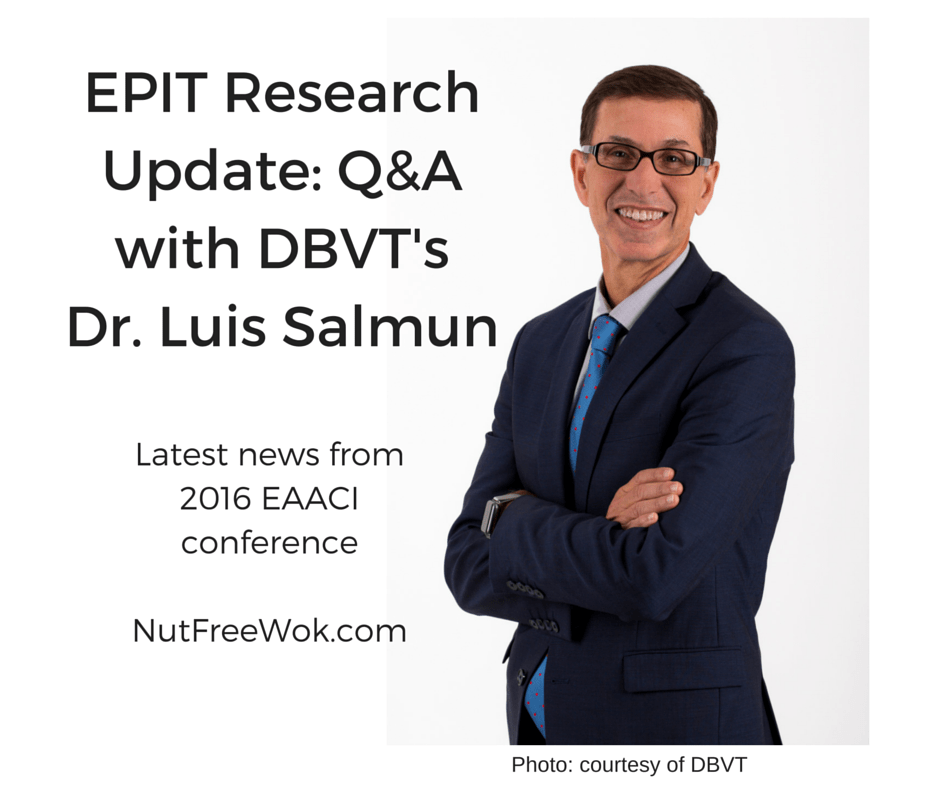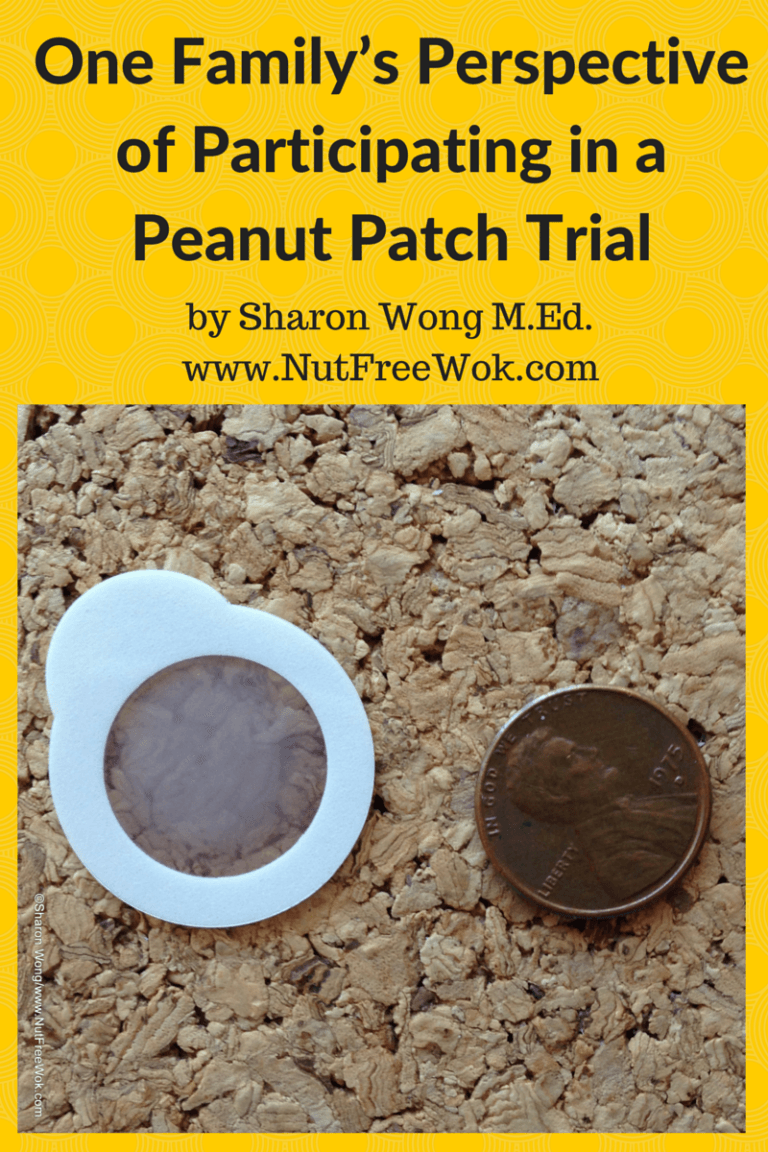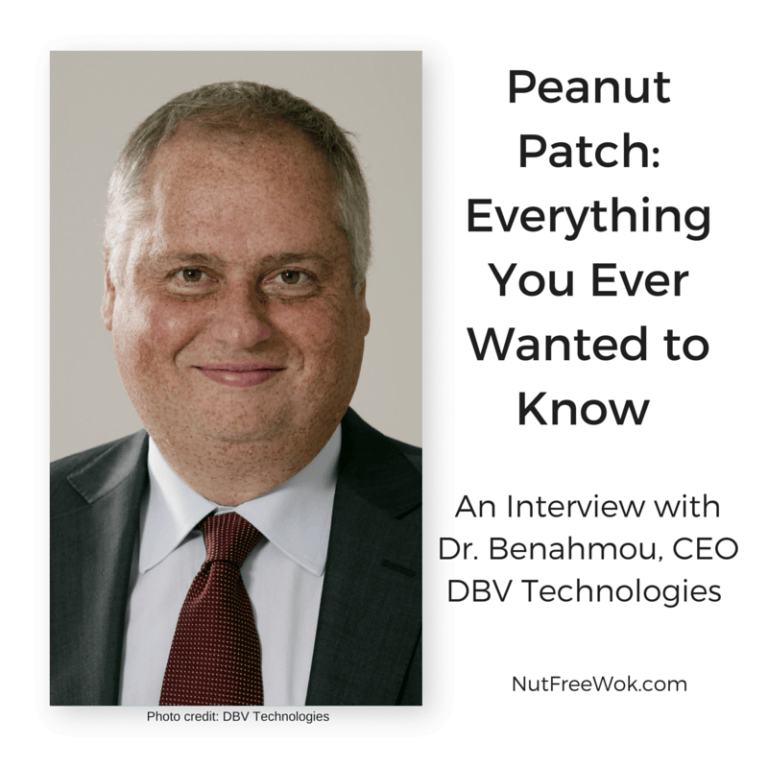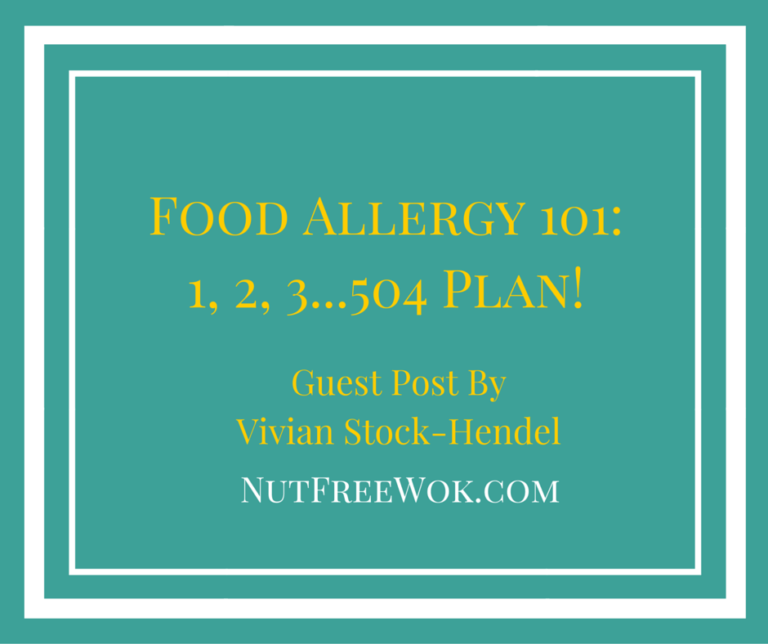EPIT Research Update: Q&A with Dr. Salmun
I am so pleased to share with you an interview about EPIT research with Dr. Luis Salmun (Vice President, Medical Affairs North America, DBV Technologies) to help us understand the significance of some of DBVT’s latest abstracts that were presented at the 2016 EAACI conference.
Editor’s note: I had some follow up questions for Dr. Salmun and DBVT but to date, have not heard back from them or their representatives. I’m publishing the interview as is and hope that there will be additional details as the trial(s) progress. I wish them the best of luck and look forward to additional updates as they become available. ~Sharon
DBVT is a French pharmaceutical company founded by a group of doctors who were very concerned about their patients with food allergies. Currently the standard accepted treatment for food allergies are avoidance and rapid administration of epinephrine in case of an allergic reaction. Epicutaneous Immunotherapy (EPIT) taps the skin’s immune system to treat food allergies, which bypasses the digestive system and results in minor skin reactions as a side effect.
I first became interested in DBVT’s research when our family first considered enrolling my son in the VIPES/OLFUS trial and have shared my son’s experience in the trial as well as an interview with Dr. Henri Benhamou, DBVT’s CEO previously. People often ask me how is my son doing since he completed his trial in December 2015 and want an update. I feel very strongly against the possibility of misleading anyone to think that my son’s experience would be indiciative of the overall results of the trial. I would like to wait until the VIPES/OLFUS results are announced before sharing an epilogue publicly. It is safe to say that our family is grateful to everyone who has loved us through out this process and we are forever grateful to those who are committed to finding a treatment for food allergies. I am so happy to share with you these research updates because we all need hope for a safer future.
Disclaimer: DBVT’s Viaskin Peanut and Milk products are currently in various phases of clinical trial research and are not yet FDA approved. All opinions are mine and this post is not sponsored. I am not a medical professional, this interview is for informational purposes only. If you have any medically related questions, please discuss them with your medical care team. If you like this interview, please use the sharing tools below. All rights reserved, copying is strictly prohibited.
EPIT Research Updates from EAACI
NFW: I would like to convey my readers’ as well as my own heartfelt appreciation for DBVT’s vision and passion to pursue EPIT as a potential food allergy treatment. We all need hope that our loved ones might have options to treat food allergies. Readers whose loved ones are currently enrolled in a Viaskin trial would like to let you know how much they appreciate the opportunity to be involved.
Thank you, Dr. Salmun for taking the time to help me and my readers who are interested in the latest in EPIT food allergy research to understand the significance of some of the latest research presented about DBVT’s Viaskin patches and EPIT research. Congratulations to the DBVT team on winning “Best of Poster Discussion Session” Award at the EAACI conference, we look forward to learning more about th presentations.
Biomarkers
NFW: The VIPES/OLFUS phase II peanut patch trial has yielded some very interesting data that may lead to doctors being able to monitor their patients’ desensitization progress via blood tests. Please tell us more about the abstract “Prediction of peanut challenge outcomes with biomarkers” and what biomarkers will indicate a good chance of a passing an oral food challenge? Are an increase in the ratios of peanut specific IgG4 to allergenic markers such as peanut specific IgE and Ara h2 IgE more predictive of desensitization? How will knowing these biomarkers help patients?
Dr. Salmun: Thank you for the opportunity to address these questions. In clinical trials, we have observed that Viaskin Peanut may lead to specific immunologic changes. Based on the VIPES/OLFUS data, we were able to start working on the development of a proprietary algorithm that may eventually help us monitor patients’ response to the treatment. We have observed that treatment with Viaskin Peanut leads to a decrease of peanut specific IgE and Ara h subtypes, as well as an increase in peanut specific IgG4. A combination of these ratios and other parameters are being used in the algorithm. New data from ongoing studies will contribute to strengthen the model. The objective is to provide an additional tool to physicians, patients and caregivers to evaluate the progression of treatment with Viaskin Peanut.
NFW: Before we get to the next topic and at the risk of appearing ignorant, would you kindly explain how experiments using mice help us make predictions about how EPIT will work in humans? Some of the experiments which test for sustained tolerance take place 8 weeks post treatment. Approximately how long are 8 mice weeks compared to humans?
Dr. Salmun: I’d like to precede this answer by making it clear that any animal study should always be validated in humans. It’s common and appropriate to conduct initial studies in animal models. Mouse experiments could be good predictors of the mechanism of action of EPIT in humans as the immunological pathways are quite close. We worked on sensitized mice based on their specific IgE level as in humans and observed the efficacy of the treatment on that marker (as well as on the protection against anaphylactic reactions).
Regarding the duration of treatment, if we were to correlate time between mice and humans, 8 weeks in mice could correspond to 3 years in humans. So showing a maintenance of the protection 8 weeks after being off treatment is reflective of long term effect in mice. As I mentioned, this needs to be further studied in humans before making additional claims.
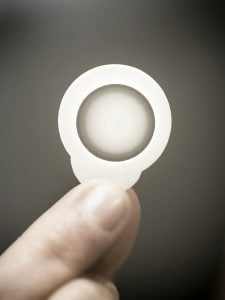
Bystander Effect
NFW: I’ve been fascinated by the potential bystander effect of EPIT and in very simple terms would you tell us more about the two experiments mentioned in the abstract “EPIT-induced bystander effect mainly conferred by naïve Tregs via soluble factors and cell-cell contact in a murine model” and what are the implications of the results for human subjects? Are you learning of anecdotal reports of current EPIT clinical trial patients unexpectedly outgrowing other food allergies?
Dr. Salmun: In an animal model, we have shown that treatment with EPIT to one allergen may prevent sensitization to other allergens. We have shown that EPIT treatment leads to a significant increase of Foxp3+ Tregs, more specifically effector Tregs (activated by an antigen) and naïve Tregs (no specificity to an antigen and we believe they may have a crucial role in blocking sensitization to other allergen). At this stage, we do not have human data on a possible bystander effect.
More Than a Skin Deep Response
NFW: The results of peanut sensitized mice treated with EPIT, OIT, or SLIT were compared in the abstract “Gut homing receptors designate epicutaneous immunotherapy as the most appropriate route for the treatment of food allergy in a model of peanut sensitized mice.” It seems that EPIT induced more Foxp3+ Tregs and additional gut homing receptors compared to OIT and SLIT and protected the mice from eosinophil infiltration in esophagus. Please help me and readers to understand what do you learn about EPIT from these results and can one infer that post EPIT treatment a patient can eat the allergen on a regular basis with greater protection from digestive complications?
Dr. Salmun: This animal model shows that EPIT is able to induce Tregs that can migrate to the digestive tract and protect from inflammation. It appears that this effect is greater with EPIT than with SLIT and OIT. We show that delivering the allergen through the skin can induce a strong regulatory response in the esophagus and intestine. The maintenance of this Tregs population and their migratory properties may lead to a long term effect. As you mentioned, this was a mouse model study, so we can not speculate on the actual clinical implications.
NFW: There were also presentations regarding the characterization of the peanut proteins in Viaskin Peanut as well as how EPIT is effective even in Filaggrin deficient mice. Is there anything else you would like to tell us about DBVT’s latest research updates and what we can look forward in the next 6 months?
Dr. Salmun: We will be investigating the skin immune response with EPIT, which could support the unique induction of Tregs populations— different from other immunotherapies— with more suppressive and sustained effect.
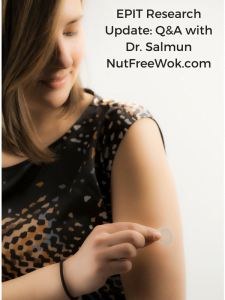
FAQ from Readers:
NFW: Before we conclude our interview, my readers also have some frequently asked questions for DBVT, some of which you might have answers for us now or perhaps in the future.
Readers are eager to learn more about follow up studies for older peanut allergic patients. Do you have any updates regarding phase III trials which include teens and adults?
Dr. Salmun: DBV is committed to addressing the needs of all food allergic patients. We hope that as we continue to progress in the current studies, we will be able to further our clinical development in other populations, including teens and adults.
NFW: Are you considering additional options to achieve a higher level of tolerance if a patient wanted to be able to tolerate more than just a bite of their allergen? Will there be higher dose patches available in the future or does one wear them longer?
Dr. Salmun: For Viaskin Peanut, the goal is to provide treatment that will prevent reactions from accidental exposures to peanuts. With that objective in mind, we’re conducting our clinical development program with one patch dose that has to be worn on a daily basis following a simple schedule.
NFW: Are there plans for the patch to be worn indefinitely? And if not then can you describe how patients will potentially manage their food allergies after they complete their Viaskin treatment? Do they transition to eating their allergen regularly? How will they know they have sustained tolerance to bite proof amounts if they don’t like eating their allergen?
Dr. Salmun: The clinical development program looks at one year of treatment with Viaskin Peanut vs. Placebo. After that year, we are also collecting open label data for up to 2 more years. Additionally, we are exploring sustained unresponsiveness 2 months after treatment completion. We foresee that the appropriate length of therapy will be decided by the prescribing physician in discussion with the patient/caregiver and based on each individual situation.
NFW: What can you tell us about the cost of treatment? Will it be covered by medical insurance?
Dr. Salmun: Through our initial interaction with payers, they have recognized that treatment of peanut allergy is an important unmet need. We are confident that upon approval we will establish strong formulary access and reimbursement.
NFW: People are curious about what patches are in development. Are you considering a patch for tree nut allergies with a nut specific patch or an all in one tree nut patch? Will there be a patch for wheat?
Dr. Salmun: We currently are in Phase 2 clinical trials of Viaskin Milk, and we’re in the preclinical stage of development of Viaskin Egg.
NFW: Since many patients are managing multiple food allergies, is it possible to havecombination patches in the future (for example a milk + egg patch) or wear multiple patches at the same time (for example a milk patch and a peanut patch)? Is there a way to desensitize to any allergen, such as a non-top 8 allergy such as sesame or garlic?
Dr. Salmun: Our current focus is on the development of Viaskin Peanut, Milk and Egg. As we progress, we’ll evaluate other possible relevant treatments to consider.
NFW: What is your approximate timeline to apply for regulatory approval in the US and in other countries?
Dr. Salmun: We have just completed enrollment in our Phase 3 study (PEPITES) for Viaskin Peanut. We foresee completing the double-blind placebo controlled trial in the second half of 2017. Based on that, we’ll follow with the appropriate submissions to the regulatory authorities who will conduct the appropriate review and then will the decide the timing of the approval.
NFW: Will there be possible follow up studies to extend any of the current clinical trials or a way for patients to opt to receive additional patches until they are desensitized?
Dr. Salmun: Both our Phase 2 (VIPES) and our Phase 3 (PEPITES) studies include an open label extension option that gives every patient enrolled in the study the opportunity to receive treatment with Viaskin Peanut for up to 3 years.
NFW: A young child “also wants to know how they plan to fix the problem with the patches falling off all the time and the extreme itchiness when it gets very hot outside?”
Dr. Salmun: As we have conducted multiple clinical trials that have included different products and doses, including placebo, it’s impossible for me to speculate on the specifics of his/her situation. I’d recommend that they contact the principal investigator at the study site to further discuss the situation
NFW: Many thanks again, Dr. Salmun and DBVT for the honor of interviewing you and for taking time out of your busy schedule to share your latest research news about EPIT and DBVT’s Viaskin products and for taking the time to answer readers’ questions. We eagerly anticipate DBVT’s continued progress.
Thanks for reading, please help Nut Free Wok!
The best way to see every post or recipe is to subscribe to Nut Free Wok’s email subscription (be sure to respond to the confirmation email). You will to be notified by email next time I publish another post or recipe and I won’t send you spam or share you email with anyone.
If you enjoyed this post, please use the social media buttons below to share with others. I am on Facebook, Twitter, Pinterest, and Instagram as @nutfreewok and it’s great to chat and interact on social media too.
Disclaimer: DBVT’s Viaskin Peanut and Milk products are currently in various phases of clinical trial research and are not yet FDA approved. All opinions are mine and this post is not sponsored. I am not a medical professional, this interview is for informational purposes only. If you have any medically related questions, please discuss them with your medical care team. If you like this interview, please use the sharing tools below. All rights reserved, copying is strictly prohibited.

